In the end I went to Barcelona because the tickets were cheap (30euros return) and by that point (in January, when I was planning the trip), I really didn’t feel like spending the rest of my holidays in France. I’m so glad I did, because it was one of the best parts of the trip.
Mambo Tango Hostel
Actually I didn’t do much while in Barcelona: most of the time I slept or sat around the hostel. In truth, I was exhausted; but also the atmosphere in the hostel was good. It was all long term travellers and experienced backpackers (with the exception of the two Canadians I’d met, who were on their first trip out); there was a group of Slovenian skater-boys with their boards, bmxes and video cameras who were always good for a laugh. No Australians. I was glad of this, as, due to it’s reputation and fame, Villa St. Exupery (in Nice) was full of first-time-travellers aged around 18 to 21, who I generally don’t have much in common with, anymore. They did manage to break me out of my solitude and drag me out to bars (which are pretty decent in Barcelona; the only problem being the cigarette smoke); though I drew the line at going dancing. Certainly when I travel, as when I’m at home, I prefer to buy a bottle of something and get quietly and nonsensically drunk at home (or at the hostel bar) amongst good company – I did do this too, with $3AUD bottles of wine, with Kaila, a well-travelled Brazilian.
The atmosphere in the hostel was created and maintained by the hostel’s owners, two lifelong backpackers who decided to turn their house into a hostel. They offer free meals, learn every guest’s name (I was told off for not saying ‘hello’ and ‘how are you’ to Toti in the morning, frequently: people who know me know I tend to pretend I’m not there rather than greet people), organise group walks, and make guests agree to a code that encourages striking conversations with other travellers (It’s all about the ‘Hi, how are you, where are you from?’). It’s the kind of hostel that L’Imbarcadero in Venice desperately wants to be, but actually succeeds: the hostel was full, the atmosphere was great the entire time, and you’re made to feel welcome (instead of a source of cash). However, one complaint: breakfast was Melba toast and sugary conflakes. Nasty.

Mambo Tangoers
Gaudi
Anyway, the original idea of going to Barcelona was to see the works of Gaudi – we studied Gaudi in year 12 Art, for the architecture section. Ever since, I’ve always wanted to see the Sa Grada Familia. If you’ve never heard of Gaudi, well, he lived 1852-1926, he’s one of the world’s most individualistic and brilliant architects, who used the forms, geometrics, and structures of nature in his buildings. There’s not much in modern architecture, for me, that is spectacular; I can appreciate the technical and historical significance of Frank Lloyd Wrights’s buildings, for example, but they still look like concrete boxes: it’s been copied and copied so much that it has lost it’s uniqueness. However, Gaudi is Gaudi and I assure there is nothing like his work anywhere in the world. Gaudi is Barcelona.
So I’ll shut up and show you what I’m talking about:
Park Guell

Astro Boy at Park Guell.
One place is Park Guell – a gorgeous failure in urban development, it was intended to be a walled community for the wealthy, and was a spectacular economic failure. More recently, the local government of Barcelona bought the property and opened it as a public park – they now use part of the premises as a school.
It is magnificient and bizarre, and I loved the place.

Gardens in Park Guell.
Everything has a link to nature, from concrete formed grottos to the curving cieling of the terraces.
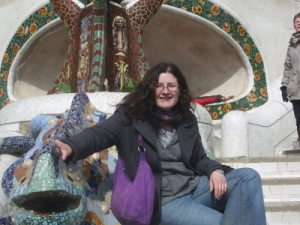
Sitting on Park Guell's lizard, very comfortable and adorable.
The lizard is a fountain: he’s gorgeous and so cute. Everyone queued up to get their photos taken. I took extensive photos because I really would like to make a replica at home – I’ve been mosaically inspired by the park.
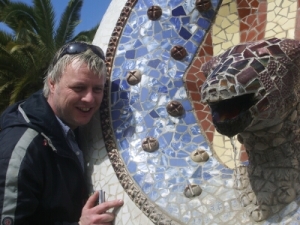
Another Mambo Tangoer, Brit Darren loves this lizard fountain.
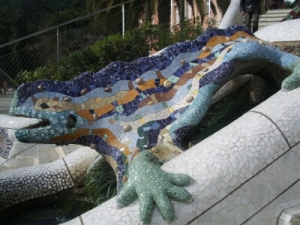
The lizard of Park Guell!

Cieling of the Park Guell terrace.
Notice the ‘natural’ feel of the architecture, and the marvellous mosaics, created from cracked pottery and crockery.

Looking out towards the gates, at the top of the stairs.

Cieling rose made from crushed crockery, magnificent.

Mambo Tangoers rest on the terrace.

The one pink pigeon in the village.
We weren’t sure about this pigeon – whether he was a different breed from the others, or if some fool had caught him and coloured him in. Either way, it was quite funny – though, actually, he was ostracised from the other pigeons, and now I feel sad for it – someone’s ‘harmless’ prank will probably lead to it’s death.

Gaudi's house in Park Guell - not designed by Gaudi, but one of his mates.
Casa Batlo
The Bone house is an apartment building renovated by Gaudi for the Batlo family. It’s absolutely incredible. I hummed and hahed all week about whether or not I could afford the $27AUD entrance fee (! – and that’s the reduced price, too); in the end, I decided I could. It was magnificent inside (though nothing is worth paying such a ridiculous entrance), especially when you consider there are a) no corners, and b) no straight lines in most parts of the building.

The bone-like exterior of Casa Batlo.
The interiors are supposed to represent the sea or the ocean – they give you the same swooping feeling of the ocean without one sign of kitschy fish, marine colours, or boats.
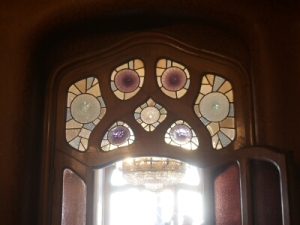
Windows leading into the parlour. The glass is lovely, and changes colour in different lights. Notice, no corners around the doors - each piece was handcarved.

The cieling and chandelier of the parlour, representing a whirlpool.

The handles on the windows were designed in clay to be ergonomic - fitting the handc comfortably.

The back yard patio.
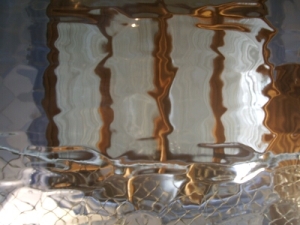
Specially made glass, made to look like you're looking through water, into the central courtyard.

The 'chimneys', covered in crushed crockery mosaics.

More chimneys.

The attic, modelled on the ribcage of a whale.
There is also Casa Pedrera, another famous Gaudi building which I couldn’t afford to enter. The pictures seemed unreal – and apparently it has an amazing roof, where there are more bizarrely sculptural chimneys.

Casa Pedrera, another famous Gaudi building.
Sa Grada Familia
The main event is the pinnacle of Gaudi’s life: the unfinished 120 year old temple, the Sa Grada Familia. Commissioned for a particular group of nuns, Gaudi died before it could be finished: thanks to facism, most of his models and plans were destroyed, so current construction continues along interpretations of Gaudi’s work. The current architect is doing a good job, although he does have his own style. It’s due to be finished in 2025 – fingers crossed – and I can’t wait to return.
I did, again, hum and ha about the entrance fee – unfortunately, there’s not much to see on the inside because of ongoing construction: but I had to go in. The museums and extra areas (which are not clearly signposted, so if you do go, really look around before leaving, to find them) were interesting, but only because I knew a little about the significance of his architectural style – otherwise, most people wouldn’t find entrance worth it.

Sa Grada Familia - with crane.

Nativity facade - the side completed during Gaudi's time. It's intense.

The interior - sweeping tree trunks, leading up to a cieling higher than the Koln Cathedral.
You can’t tell in the photos, but the church is massive. It’s going to be huge. The tallest towers haven’t even been begun yet. Currently, the workers are focusing on the interiors – the immense weight of the towers will be supported by tree like geometric towers.

The forest inside Sa Grada Familia.

Model of the mosaic work on the inside of each tree.

Model showing the geometrics behind the design of the cieling. Gaudi was a leader in using nature and geometry to inspire new building structures.
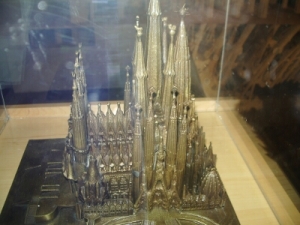
Model showing the intended final product: only the facade to the lower right and the opposing facade on the other side have been built. The hall, and remaining eight towers have yet to be built.

Scale model of the intended interiors, like a forest. Can you see the tiny people walking around inside? Getting an idea of the scale, yet?

The numerogram, which the new architect has worked into several parts of the building. Every combination adds to 33, the age of Christ when he died.

Light peeking through the scaffolding.

The Passion facade, which is by the new architect.
The newer facade is pretty spectacular, and quite retro: once I learned the idea behind it, it’s actually quite fascinating. What the sculptures represent – in a sweeping S – is the story of the passion, finally finishing in Christ’s ascension – which is represented by a little gold Christ figure sitting happily on a ledge near the top of the towers (see him the above picture, at the top?)

Diagram explaining the Passion facade, stolen from another website. Note: the ascended Christ hadn't been finished when this pick was taken - he's supposed to be about halfway up the two central towers, on a ledge which connects them.
So, I thought that was really clever, even for a non-religioso like me.
Other cool stuff in Barcelona
Okay, quickly now:
There’s a lot of wicked public spaces in Barcelona. For example:

City structures, graffiti and public spaces are cool in Barcelona.

Font Magica, Art museum, in the day.

Space near the train station.
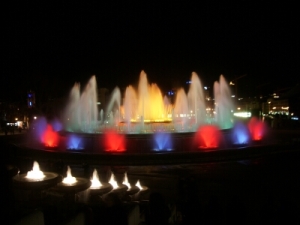
Font Magica at night.

Font Magica.
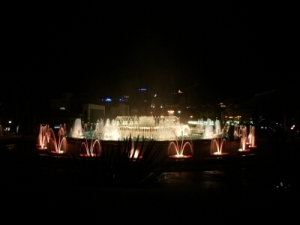
Font Magica.

Looking down towards the Font Magica.
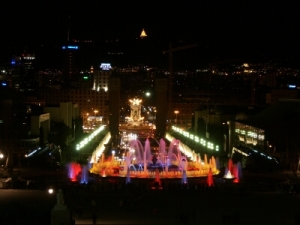
Font Magica. The light in the distance is the cathedral atop Tibidabo.

Fontain at the base of the art museum.

Atop Mont Juic.

Across the rooftops from the art museum, with the Sagrada Familia in the distance.

Street art on the pavement.
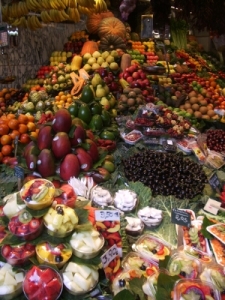
Fruit in the Las Ramblas market.
There is an awesome though touristy market worth seeing, just off the Las Rambla mall – I forget the name but it was something like Boqueria. The fruit is piled up for display, you can buy fruit packs and fruit smoothies for relatively cheap, and see some bizarre foods.
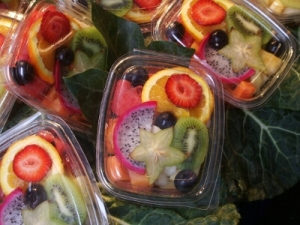
Fruit packs.
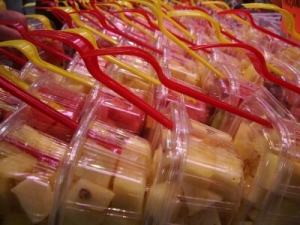
Fruit packs.

Chocolates.

Smoothies for $2AUD.

Ex-pat bar's sense of humour.
There’s a lot of foreigners living in Barcelona – I went out with a German and two Canadians, and we somehow ran into a group which included several other Germans, Kiwis and Frenchies. So the ex-pat bars were pretty awesome too. Barcelona has that ‘young but old’ city feel, like Berlin does – less old school architecture, more spirit and street cred.
Great city.
So sadly, I flew home again …
… going via Marseille, and spending the night in Marseille-Provence airport. It’s now halfway through my last 6 week term at Baggio – 3 and a bit weeks to go, before I begin my next big trip (which will be blogged about 2 months after it’s over, going by my usual blogging punctuality record).
I was supposed to be going to Sevilla, southern Spain, for Easter, to join in on the crazy Semana Santa (spell check) celebrations: but, much to my frustration, my passport (currently getting stamped with a Syrian visa – well, hopefully, at least) may not be returned in time – oh well, just $300 in flights flushed down the drain. If I can’t go, I’m going to try to use the flights to make a trip in early July – I’m real keen to see Cordoba and Granada (and the Islamic buildings there – which are apparently awesome and unusual). Madrid, however, has no interest for me.
Thanks for reading, more soon.